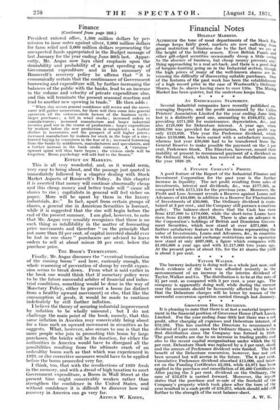Finance
"The Coming --American Boom*" THOSE readers of the financial articles in The Spectator who may wish to obtain a corrective of the sombre views which are sometimes set out in these columns concerning the financial outlook in the United States can do so by purchasing the latest booklet by Mr. Angas entitle:191T (1926) Corning American Boom. The author has obtained some notoriety by certain previous booklets dealing with such matters as The Coming Collapse in Rubber and The Coming Rise in Gold Shares (February, 1931), and it is not surprising, therefore, that his latest work dealing with The Coming American Boom should have attracted a considerable amount of attention. From more than one quarter, indeed, I have received requests that I should express my views concerning this latest forecast of Mr: Angas, and while I canicarcely hope to do justice in a short article to a booklet which covers in very complete fashion the history of President Roosevelt's experiment up to date and also supplies a mass of useful statistics supporting the idea of a coming boom, • I may, perhaps, be permitted to make some comments on a few of the points raised by Mr. Angas.
THE ROOSEVELT POLICY.
First, however, let me say that those who desire a bird's-eye view of the Roosevelt policy and the legislative measures which so far have resulted from that policy cannot do better than read the early portions of Mr. Angas's work. It is certainly pro-Roosevelt in the sense that the author credits the President with a thought-out consistent policy which to the ordinary observer has scarcely been apparent amidst the varying tactics which from time to time have been pursued and which to so many have seemed to smack of the politician rather than of the statesman and economist. With few exceptions, however, Mr. Angas regards every step taken by the President as consistent with a carefully thought- out scheme which at present is almost in its preliminary stage. One further good point, if I may so express it, in Mr. Angas's book is that he makes no attempt whatever to disguise his approVal of the process of curing industrial depression along the lines of credit and (if necessary) monetary inflation. His frankness in this respect, indeed, almost disarms criticism, but, all the same, it has to be challenged because I think it is fair to say that Mr. Angas bases his expectation of a coming boom in American securities entirely upon the prospects of inflation in America on the grand scale. In more than one place he explains the pause in the recovery in the United States by maintaining that inflation on the grand scale has scarcely begun.
" MAKING " A B003f.
For, be it' noted, the arguments for the coming American boom are not based upon expectations of what might be . termed a natural recovery in the American economic- position and American trade, but upon this improvement being brought about by monetary policy or, in other words, by an outpouring of Government money and expenditure on relief work, &c., to be supplemented, if necessary, by monetary and currency inflation. . Indeed, I should probably not be doing . justice to Mr. Angas's theories concerning monetary policy if I were not to say that apparently he disdains the old custom of allowing trade depression to be healed along the lines of lower prices stimulating consumption, the new theory favouring ever-increasing production with fresh supplies of 'credit -pumped out to enable the consumer to keep pace with the increased produetion.
MATERIAL FOR FUTURE INFLATION. •
And so with regard to the factors which are apparently relied upon to produce the coming American boom, Mr. Angas furnishes figures showing the various items making for potential expenditure and inflation. The items make up a total of nearly 20,000 million dollars, and they include 8,000 million dollars represented by permission to print paper money granted after the (Continued on page 270.) * The Coming American Boom. By. L. L. B. Angas, St. Clements Press, Ltd. (Price Etti,)
Finance (Continued from page-268.)
President entered office, 1,500 million dollars by per- mission to issue notes against silver, 2,000 million dollars for farm relief and 5,000 million dollars representing the unexpected funds appropriated in the Budget message of last January for the year ending June 80th last. Appar- ently, Mr. Angas now lays chief emphasis upon the desirability and probability of a great speeding up of Government expenditure and in his summary of Roosevelt's recovery policy he affirms that it is economically certain that the continuance of Government borrowing and expenditure will, by further increasing the balances of the public with the banks, lead to an increase in the volume and velocity of private expenditure also, and this will terminate the present seasonal reaction and lead to another new upswing in trade." He then adds " When this occurs general confidence will revive and the move- ment will gather momentum, for there will then come into general operation all the virtuous-circle factors of the business cycle : larger purchases ; a fall in retail stocks ; increased orders to manufacturers ; increased manufacture and larger industrial incomes paid out in the course of production ; larger expenditure by workers before the new production is completed ; a further decline in inventories and the prospect of still higher prices ; increased manufacture by makers for stock in the hope of a rise ; hurried buying by consumers in the fear of it ; increased borrowing from the banks by middlemen, manufacturers and speculators, and a further increase in the bank credit currency. A ' virtuous ' upward spiral will thus have begun ; the vicious circle will be forgotten. Boom psychology will add fuel to the flames."
EFFECT ON MARKETS.
This is all very wonderful, and, so it would seem, very easy to bring about, and the passage just quoted is immediately followed by a chapter dealing with Stock Market Aspects of Roosevelt's Policy. In this chapter it is asserted that money will continue abnormally cheap and this cheap money and better trade will " cause all shares to rise ; capitalists in general will feel richer on paper. More will be spent by them in the luxury industrials, &c." In fact, apart from certain groups of shares, a general rise in American Securities is forecast, while it is suggested that the rise will begin before the end of the present summer. I am glad, however, to note that Mr. Angas very sensibly recognizes that there is no such thing as infallibility in the matter of forecasting price movements and therefore " on the principle that not more than 25 per cent. of capital invested should ever be lost in one share " purchasers are advised to leave orders to sell at about minus 20 per cent. below the purchase price.
THE BOOM'S TERMINATION.
Finally, Mr. Angas discusses the " eventual termination of the coming boom " and here, curiously enough, the whole reasoning of prevention of slump by credit expan- sion seems to break down. From what is said earlier in the book one would think that if monetary policy were to be the future successful arbiter of financial and indus- trial conditions, something would be done in the way of Monetary Policy, either to prevent a _boom (as distinct from a healthy upward movement) or else, that like the consumption of goods, it would be made to continue indefinitely by still further inflation. I believe the theory of securing industrial improvement by inflation to be wholly unsound ; but I do not challenge the main point of the book, namely, that this same inflation in America may conceivably bring about for a time such an upward movement in securities as he suggests. What, however, also occurs to one is that the more people who join in promoting this boom by large purchases, the briefer will be its duration, for either the authorities in America would- have to disregard all the possibilities resulting from the ultimate crash of an unhealthy boom such as that which was experienced in 1929, or else corrective measures would have to be applied before the boom proceeded very far. I think, too, that with the recollections of 1929 fresh in the memory, and with a dread of high taxation to meet Government expenditure, a Boom in Wall Street at the present time might conceivably weaken rather than strengthen the confidence in the United States, and without confidence it is difficult to discover how real recovery in America can go very far. ARTHUR W. KIDDY.



































 Previous page
Previous page